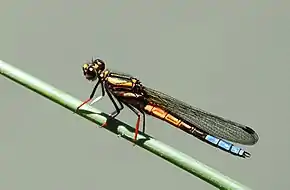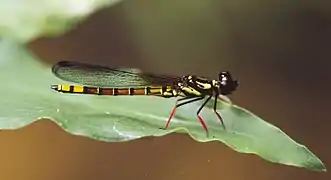Platycypha
Platycypha est un genre d'insectes odonates (libellules) du sous-ordre des Zygoptera (demoiselles) de la famille des Chlorocyphidae.
Répartition
Ce genre de demoiselles est endémique d'Afrique tropicale[1],[2],[3],[4]. Il se rencontre depuis le Cameroun et l'Éthiopie jusqu'en Afrique du Sud[1].
Habitat
Le genre Platycypha est assez commun en Afrique tropicale. Elle se rencontre jusqu'à des altitudes modérées à proximité des cours d'eau, des rivières et des lacs[1].
Dénomination
Le genre Platycypha a été décrit par l'entomologiste britannique Frederick Charles Fraser en 1949 avec pour espèce type Libellago caligata Selys, 1853[4],[5].
Description
Les demoiselles du genre Platycypha sont de taille petite à moyenne avec des ailes postérieures de 15 à 26 mm[1].
Elles sont similaires aux autres Chlorocyphidae avec un clypéus qui forme une protubérance qui ressemble à une sorte de museau, trois axillaires ou plus, l'arculus positionné à mi-distance entre la base et le nodus ou tout du moins plus proximal que distal, le quadrilatère avec 1 à 3 nervures transverses et l'abdomen plus corpulent que mince qui atteint les extrémités des ailes[1]. Elles en différent cependant par des tibia, souvent dilatés, en grande partie blanc, jaune, orange et/ou rouge avec au plus un peu de noir à l'apex[1].
Les mâles utilisent leurs tibias colorés en les exposant lors de la parade nuptiale[1],[6].
Publication originale
- (en) Fraser, C. F. 1949. A revision of the Chlorocyphidae with notes on the classification of the Selysia species rubida, glauca, cyanifrons and curta. Bulletin de l'Institut royal des Sciences naturelles de Belgique, 25(6): 1-50.
Taxinomie
- Platycypha amboniensis (Martin, 1915)
- Platycypha angolensis Longfield, 1959
- Platycypha auripes (Förster, 1906)
- Platycypha bamptoni (Pinhey, 1975)
- Platycypha caligata (Selys, 1853)
- Platycypha crocea (Longfield, 1947)
- Platycypha eliseva Dijkstra, 2008
- Platycypha fitzsimonsi (Pinhey, 1950)
- Platycypha inyangae Pinhey, 1958
- Platycypha lacustris (Förster, 1914)
- Platycypha picta (Pinhey, 1962)
- Platycypha pinheyi Fraser, 1950[9]
- Platycypha rubriventris (Pinhey, 1975)
- Platycypha rufitibia (Pinhey, 1961)
Galerie
Notes et références
- (en) Dijkstra, K.-D. B., Clausnitzer, V. 2014. The Dragonflies and Damselflies of Eastern Africa: handbook for all Odonata from Sudan to Zimbabwe. Studies in Afrotropical Zoology, 298: 1-260.
- (en) Clausnitzer, V., Dijkstra, K.-D. B., Koch, R., Boudot, J.-P., Darwall, W. R. T., Kipping, J., Samraoui, B., Samways, M. J., Simaika, J.P., Suhling, F. 2012. Focus on African Freshwaters: hotspots of dragonfly diversity and conservation concern. Frontiers in Ecology and the Environment, 10: 129-134
- (en) Kipping, J., Clausnitzer, V., Fernandes Elizalde, R. F. S., Dijkstra, K. 2017. The dragonflies and damselflies (Odonata) of Angola. African Invertebrates, 58: 65-91.
- (en) Steinmann, H. 1997. World catalog of Odonata. Volume I. Zygoptera. Walter de Gruyter, New York, 507 pages. (ISBN 3 11 014933 8)
- (en) Fraser, C. F. 1949. A revision of the Chlorocyphidae with notes on the classification of the Selysia species rubida, glauca, cyanifrons and curta. Bulletin de l'Institut royal des Sciences naturelles de Belgique, 25(6): 1-50.
- (en) Telford, S. R., Barnett, M., Polakow, D. A. 1996. The functional significance of tibial displays in the damselfly Platycypha caligata (Selys) (Odonata: Chlorocyphidae). Journal of Insect Behavior, 9(5): 835-839.
- (en) Schorr, M., Paulson, D. 2017. World Odonata List. Slater Museum of Natural History. University of Puget Sounds. Tacoma, Washington, États-Unis.
- (en) Référence Animal Diversity Web : Platycypha (consulté le )
- (en) Fraser, C. F. 1950. A revision of the Chlorocyphidae, addenda with key to the platycypha and Chlorocypha and description of new species. Bulletin de l'Institut royal des Sciences naturelles de Belgique, 26(18): 1-22.
Liens externes
- (en) Référence Animal Diversity Web : Platycypha (consulté le )
- (en) Référence BioLib : Platycypha Fraser, 1949 (consulté le )
- (en) Référence Catalogue of Life : Platycypha (consulté le )
- (fr+en) Référence EOL : Platycypha (consulté le )
- (fr+en) Référence GBIF : Platycypha Fraser, 1949 (consulté le )
- (en) Référence NCBI : Platycypha (taxons inclus) (consulté le )
- (en) Référence The Taxonomicon : Platycypha Fraser (consulté le )
- (en) Référence uBio : Platycypha Fraser, 1949 (consulté le )
- Portail de l’entomologie
- Portail de l’Afrique

_teneral_male.jpg.webp)

